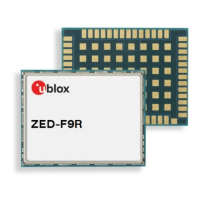ZED-F9R - Application note
UBX-22035176 - R01 Contents Page 11 of 30
C1-Public
3 Installation
The first step of setting up the ZED-F9R is installing it into the vehicle. Proper installation is vital for
the navigation performance of the receiver, as its internal sensors must be able to measure the
dynamics of the vehicle accurately in a consistent way. This means the antenna and receiver must be
mounted rigidly in a fixed position and orientation relative to the vehicle’s body.
Figure 5: Conceptual system view with good alignment
3.1 Mounting the receiver
Start by finding a suitable location in the vehicle to mount the receiver. The placement of the receiver
does not matter in most applications. For best performance, the receiver should be placed as close to
the center of the vehicle’s rear axle as possible. If the application’s accuracy requirements are very
demanding, an advanced configuration may be needed.
Next, plan the orientation of the receiver. Figure 6 shows the inertial measurement unit (IMU) frame
and the installation frame. The default assumption is that the x, y and z axes of the IMU frame are
parallel to the x, y, and z axes of the installation frame. The IMU frame orientation is printed on the
label of the C102-F9R evaluation kit; for custom designs refer to Figure 7. For the simplest possible
installation, mount the receiver in the orientation described above. If the receiver is mounted in any
other orientation, a custom configuration must be set for correct performance.
☞ Note that the configured misalignment must be within 3 degrees of the truth to prevent
significant degradation in navigation performance. A misalignment of tens of degrees will result
in failure. Consult section 3.2.3 of the ZED-F9R Integration manual [1] for more information about
the IMU alignment. Configuring the misalignment is described in section 6.2.2.

